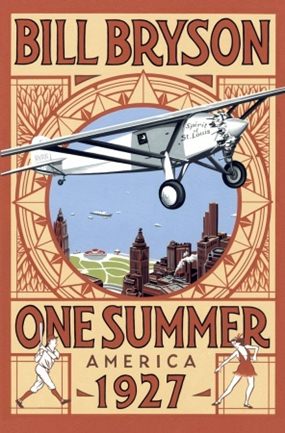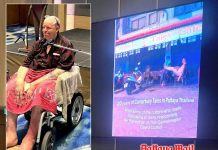I could have started this review by writing “Bill Bryson’s done it again. Go to Bookazine and buy this book. B. 468 for over 600 pages. Bargain of the year!” However, the editor expects me to write over 500 words, so I shall continue. But if you get bored with my prose, just go to Bookazine and buy it. You will not regret it.
One Summer America 1927 (ISBN 978-0-552-77940-1, Black Swan, 2014) has Bryson researching the events of that era in America, which was not the most powerful country in the world in those days.

This book has history by the gonads, and dealt out in a manner that only Bryson can. For example, did you know that America did not have tabloid newspaper before 1920, but by 1922 a tabloid had the largest circulation of all. When there were regular passenger flights in Europe between capitals, America was still in the barnstorming days with pilots left over from WW1.
Bryson has the ability to lead the reader quite astray, then return to fact, turning everything upside down that he had written before. He describes Charles Lindbergh’ scholastic achievements as “attended 11 different schools before graduating from high school, and distinguished himself at each by his mediocrity.”
I have enjoyed every one of Bryson’s books I have read so far, so it was time to really look at his style of writing and his subject matter to try and work out why he, as an author, is just so popular.
The first that comes to mind is his very detailed examination of his subjects. The early 1920’s are almost 100 years ago, but Bryson has obviously spent much time with dusty tomes in even dustier libraries to give his readers an accurate picture of some of the great characters in that time frame, such as Lindbergh, President Coolidge, Babe Ruth, Henry Ford and more.
His books cover Travel, Language, Science, Biography, History and Memoirs. 20 books written in a span of 20 years.
He writes in a narrative style, interspersed with wit, including much sarcasm, satire and irony. He provides an immediacy between himself and the readership to allow a greater enjoyment of the facts in his books. Almost a wink-wink, nudge-nudge revelation for the reader’s ears only.
In one chapter he looks at America’s social engineering attempt, called the Prohibition, in which poisons were added to industrial alcohol to stop the citizens drinking it, but killed them instead. This was why Al Capone did so well, he didn’t kill his customers.
At B. 468 for over 600 pages with small font (I would prefer larger font, Black Swan), this is a book which will take you more than one weekend to get through, and at the end you will be sorry you have finished it, being just so enjoyable. It is no small wonder that Bryson has received so many awards and honorary degrees from prestigious universities and even the keys to the city of Des Moines (USA) where he was born, and featured in his book The Life and Times of the Thunderbolt Kid.




